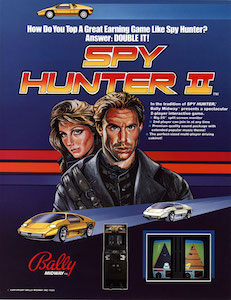| Spy Hunter II | |
|---|---|
 Sales flyer picturing the arcade cabinet and the split screen at the bottom. | |
| Developer | Bally Midway |
| Publisher | Bally Midway |
| Series | Spy Hunter |
| Platform | Arcade |
| Release | 1987 |
| Genre | Vehicular combat |
| Modes | Single-player, multiplayer |
Spy Hunter II is a 1987 vehicular combat arcade game developed and published by Bally Midway. It is the sequel to 1983's Spy Hunter . Unlike its predecessor, Spy Hunter II was not ported to any contemporary systems and remained obscure. George Gomez, who designed the original, was critical of the sequel as it was made by Bally Midway without his involvement. [1]